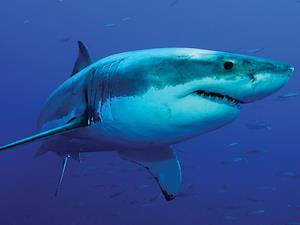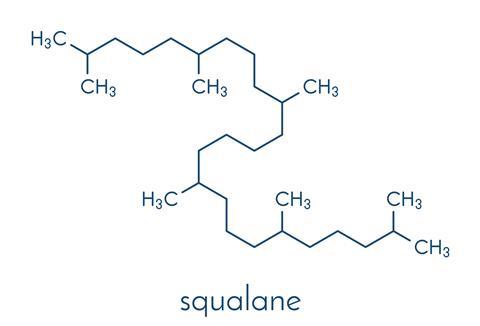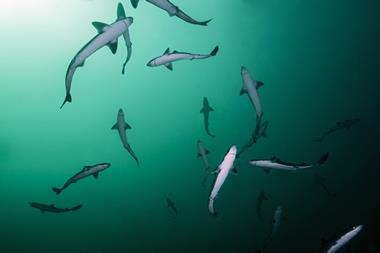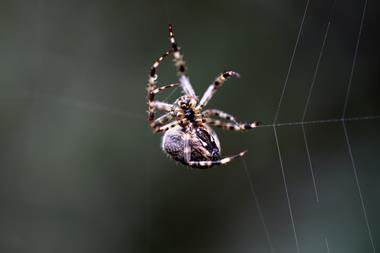Meera Senthilingam
This week, science writer Helen Scales takes to the sea.
Helen Scales
The idea that sharks have to keep swimming in order to breathe is nothing but a myth (there are plenty of sharks that spend most of their lives resting happily on the seabed). But it is true that if sharks don’t keep swimming they will sink. The reason is that they don’t have a gas-filled balloon, known as a swim bladder, like most bony fish do. Instead sharks have evolved large, oil-rich livers that help boost their buoyancy, although not as much as if they carried around a bubble of air inside them. A major component of that shark liver oil is an organic molecule called squalene.

This is a thirty-carbon molecule, with fifty hydrogen atoms, and an important feature of it for sharks is its low density: at around 0.85g/cm3 it is less dense than saltwater, which is why it helps to keep sharks buoyant in the water column. Another property of this molecule is being harnessed by people, after researchers discovered that it helps to make vaccines more effective - in particular the flu vaccine.
Squalene is used as what’s known as an adjuvant, an effect originally discovered in the 1920s by French researcher Gaston Ramon. He found that adding certain substances to vaccines produced a stronger immune response and he called them adjuvants after the Latin verb adjuvare, to help. Ramon developed adjuvants based on aluminium salts, mainly aluminium hydroxide, which is still used for all sorts of vaccines from meningitis to rabies.
Conservationists are increasingly concerned that sharks are being targeted for their squalene
In the 1990s researchers at Novartis developed a new vaccine adjuvant, MF59 which incorporates squalene, and it’s used in various flu vaccines including against swine flu.
It’s not exactly clear how adjuvants work, but they have the effect of attracting immune cells to the site where the vaccine is injected and promotes the uptake of vaccine antigens into immune cells, boosting the immune response. And by doing that, it means that a lower dose of the antigen can still be effective.
A controversy flared up over the alleged use of MF59 in anthrax vaccines given to military personnel fighting the Persian Gulf War in the nineties. There were claims that squalene in the vaccine was linked to so-called Gulf War syndrome reported by combat veterans who suffered from a range of unexplained chronic symptoms; a study found more antibodies against squalene in veterans reporting these symptoms compared to those who were in good health. But, it was later uncovered that the anthrax vaccines hadn’t in fact been used with squalene. Traces of the molecule in tests may have come from a human fingerprint because we produce squalene in the oils in our skin. And some people naturally produce squalene antibodies. Also, just like sharks, we make it in our livers in our case mainly as a precursor of cholesterol and steroid hormones.

Plants and fungi also make squalene and it can be extracted in small quantities from olives, wheat germ, rice bran and it’s even found in the stomachs of some birds. But the main source of squalene for vaccines and other uses is from sharks.
Conservationists are increasingly concerned that sharks are being targeted for their squalene, in particular deep sea sharks which have huge livers that can account for up to a third of their body weight. These slow growing, long-lived animals, including species like the weird-looking gulper sharks with enormous mouths, are highly vulnerable to being overfished and many millions of them are caught each year for their squalene.
As well as vaccines, shark squalene is also used in cosmetics. Being a natural oil in human skin, cosmetics manufacturers claim that it makes a powerful moisturizer and add it to face creams and lipstick. Shark squalene is also promoted by health food companies who sell it in capsule form and it’s been used an ingredient in hemorrhoid creams.
But campaigns to save the sharks are slowly persuading people that smearing shark oil on their faces and popping sharks pills is not a great idea. Pharmaceutical companies may be a way off replacing shark squalene in vaccines but for cosmetics and health supplements it’s a no-brainer. With alternative, plant-based options out there it’s high time we left the sharks and their oily livers alone.
Meera Senthilingam
Science writer Helen Scales there, with the oily, yet beneficial chemistry of squalene. Now, next week, some pain relief.
Nate Adams
Desomorphine, or dihydrodesoxymorphine is an opioid like morphine or heroin. That means it is a powerful painkiller, but like morphine and heroin, it’s also highly addictive.
Meera Senthilingam
Discover why with Nate Adams, in next week’s Chemistry in its Element. Until then, thank you for listening, I’m Meera Senthilingam.













No comments yet